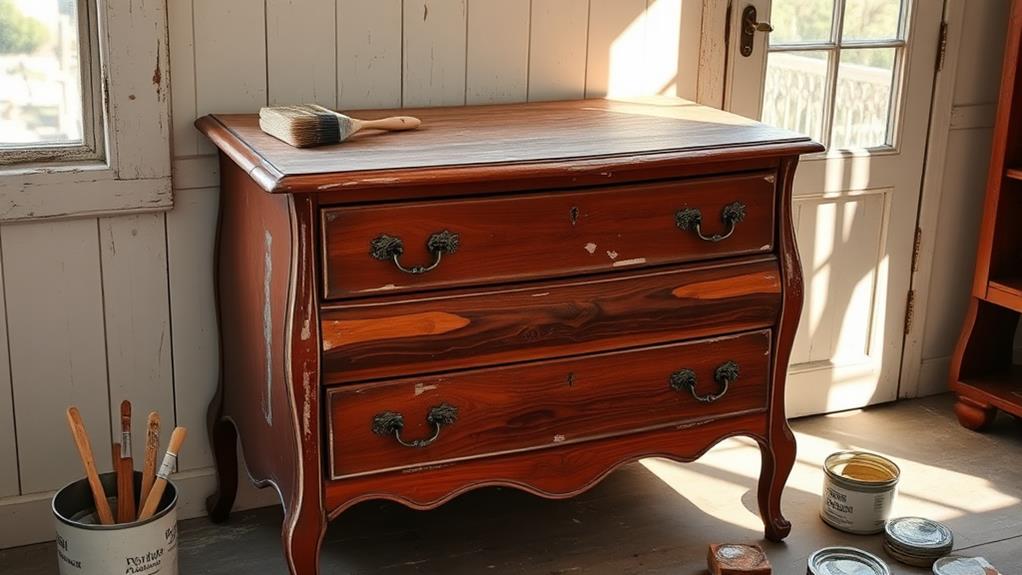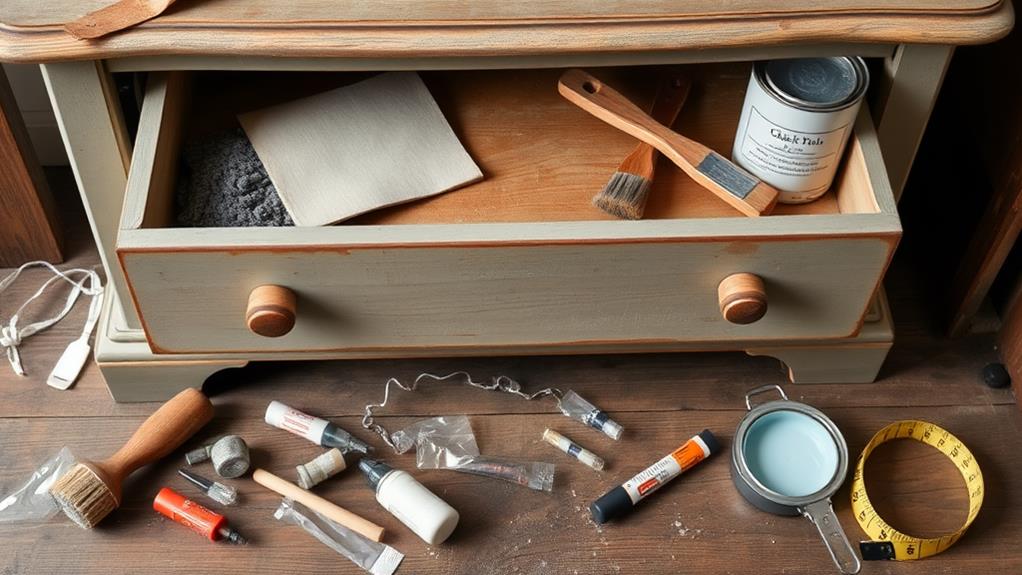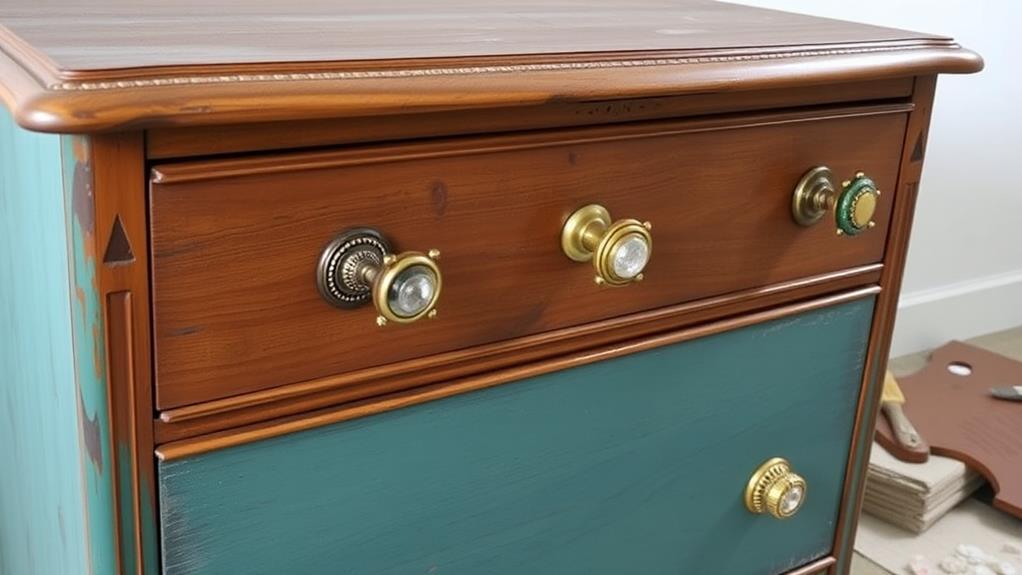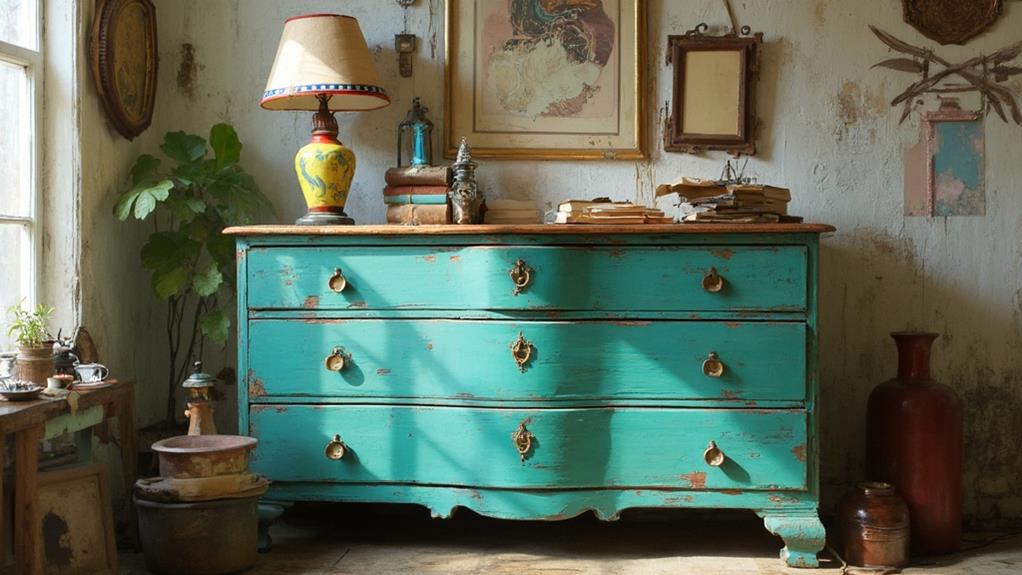Transforming thrift store furniture into stunning home decor pieces is an exciting and rewarding DIY project. Start by identifying quality construction and classic designs with potential for updating. Essential tools include sandpaper, paint brushes, and basic repair supplies. Properly prep the piece by cleaning, repairing, and sanding before applying your chosen painting technique, such as chalk paint or spray painting. Upgrade hardware and add embellishments for a custom touch. For upholstered items, consider reupholstering with fresh fabric to completely revitalize the piece. With creativity and effort, you can breathe new life into forgotten furniture and create unique, personalized additions to your home.
Spotting Potential in Secondhand Furniture

At first glance, thrift store furniture may appear worn or outdated, but savvy shoppers know how to identify pieces with hidden potential. The key is to look beyond the surface and focus on the underlying structure and quality of the item. Solid wood construction, dovetail joints, and sturdy frames are indicators of well-made furniture that can withstand refurbishment.
When assessing potential, consider the overall shape and style of the piece. Classic designs and timeless silhouettes are easier to update and integrate into modern decor. Pay attention to details like ornate carvings, unique hardware, or interesting textures that can become focal points after restoration.
Evaluate the extent of repairs needed. Minor cosmetic issues like scratches, dents, or outdated finishes are relatively easy to address. However, be wary of extensive structural damage or signs of pest infestation. Check for wobbling, loose joints, or musty odors that may indicate more serious problems.
Essential Tools for Furniture Makeovers
To embark on successful furniture makeovers, having the right tools at your disposal is crucial. A basic toolkit for furniture restoration should include a variety of sandpapers, ranging from coarse to fine grits, and a sanding block or electric sander for larger surfaces. Paint brushes in different sizes, foam rollers, and a small foam brush for detailed work are essential for applying paint or stain evenly.
A screwdriver set with multiple heads, pliers, and a hammer are necessary for disassembling and reassembling pieces. Wood filler and wood glue are indispensable for repairing damages or loose joints. For refinishing, invest in quality paint stripper, mineral spirits, and protective gear such as gloves and a respirator mask.
A measuring tape, level, and carpenter's square ensure precise cuts and alignments. If you plan on reupholstering, a staple gun, fabric scissors, and upholstery tacks are must-haves. Don't forget cleaning supplies like all-purpose cleaner, degreaser, and microfiber cloths to prep surfaces before starting any work. With these tools on hand, you'll be well-equipped to tackle various furniture makeover projects and breathe new life into thrift store finds.
Prepping Your Thrift Store Find

Proper preparation is the cornerstone of any successful furniture makeover project. Before diving into the transformation process, it's crucial to thoroughly clean and assess your thrift store find.
Begin by removing any hardware, such as knobs or handles, and set them aside. Next, clean the piece thoroughly using a mild soap and water solution, paying special attention to crevices and hard-to-reach areas.
Once clean, inspect the furniture for any damage or structural issues. Repair loose joints, fill cracks or holes with wood filler, and sand down rough spots. If the piece has a glossy finish, lightly sand the entire surface to create a better base for paint or stain to adhere to.
For painted furniture, determine if the existing paint contains lead, especially for older pieces. If lead is present, take necessary safety precautions or consider professional removal. Remove any peeling or chipping paint, and use a deglosser or liquid sandpaper to prepare the surface for a new coat.
Painting Techniques for Upcycled Pieces
Painting techniques can breathe new life into upcycled furniture, transforming worn-out pieces into stunning focal points. When approaching an upcycling project, consider various painting methods to achieve the desired effect.
Chalk paint is a popular choice for its matte finish and excellent coverage, often requiring no primer. For a distressed look, apply milk paint and sand strategically to reveal underlying layers.
Spray painting offers a smooth, even finish for intricate pieces or those with hard-to-reach areas. For a more textured appearance, try dry brushing or color washing techniques. Stenciling and hand-painted designs can add unique patterns or motifs to plain surfaces. Ombre effects create a gradual color transition, while color blocking introduces bold geometric shapes.
To protect your newly painted piece, apply a clear topcoat or wax. This step enhances durability and can alter the sheen from matte to glossy. Experiment with different techniques on scrap wood before committing to your furniture piece. Remember that proper surface preparation and high-quality materials are crucial for achieving professional results in your upcycling projects.
Hardware Updates and Embellishments

While painting can dramatically transform a piece of furniture, updating hardware and adding embellishments can elevate its aesthetic appeal even further. Replacing outdated knobs, handles, and pulls with modern alternatives can instantly refresh the look of dressers, cabinets, and drawers. Consider using sleek metallic finishes, vintage-inspired glass knobs, or even leather pulls for a unique touch.
Embellishments offer another avenue for customization. Decorative moldings can be added to plain surfaces, creating visual interest and a more upscale appearance. Attaching mirror panels to drawer fronts or cabinet doors can add depth and light to a piece. For a bohemian flair, consider incorporating fabric inlays or decoupage techniques using patterned paper or maps.
Other embellishment options include adding decorative nailhead trim, applying gold leaf accents, or attaching ornate metal corner protectors. These small details can make a significant impact on the overall design. When selecting hardware and embellishments, ensure they complement the style and era of the furniture piece, creating a cohesive and polished final product that looks intentional rather than haphazardly assembled.
Reupholstering Thrifted Furniture
Reupholstering thrifted furniture can breathe new life into worn or outdated pieces, transforming them into custom creations that perfectly suit your style and decor. This process involves removing the old fabric, repairing or replacing the padding, and applying new fabric to create a fresh look.
Begin by carefully removing the existing upholstery, taking note of how it was attached. Clean and repair the frame if necessary, and replace or add foam padding to improve comfort and shape. Choose a durable, high-quality fabric that complements your home's aesthetic and can withstand daily use.
Measure and cut the new fabric, allowing extra material for wrapping and securing. Use a staple gun to attach the fabric, starting from the center and working outward to ensure a smooth, taut finish. Pay special attention to corners and curves, pleating or tucking as needed for a professional appearance.
For more complex pieces like chairs with separate cushions, create new covers using the old ones as patterns. Finish by reattaching any trim or decorative elements. With patience and attention to detail, reupholstering can significantly elevate the look and value of thrifted furniture.
Frequently Asked Questions
How Do I Negotiate Prices at Thrift Stores?
To negotiate prices at thrift stores, politely inquire about potential discounts, especially for multiple items. Point out any flaws or imperfections respectfully. Be prepared to walk away if necessary, and consider visiting on sale days for better deals.
What Are the Best Days to Shop for Furniture at Thrift Stores?
Time is money when it comes to thrift store furniture shopping. Typically, weekdays offer better selections, with Mondays and Tuesdays being prime days for fresh inventory. Avoid weekends, as they're often busier with fewer bargains available.
How Can I Remove Musty Odors From Secondhand Furniture?
To remove musty odors from secondhand furniture, try these methods: air it out in sunlight, sprinkle baking soda and vacuum, use white vinegar spray, apply activated charcoal, or employ an ozone generator. Persistent odors may require professional cleaning services.
Are There Any Health Risks Associated With Refurbishing Old Furniture?
Refurbishing old furniture can pose health risks due to potential exposure to lead paint, mold, dust, and harmful chemicals. Proper safety precautions, such as wearing protective gear and working in well-ventilated areas, are essential to minimize these risks.
Can I Sell My Upcycled Furniture Pieces for Profit?
The upcycled furniture market is projected to reach $989.8 million by 2028. Selling refurbished pieces for profit is certainly possible. Many entrepreneurs have successfully turned this hobby into a lucrative business by leveraging online marketplaces and social media platforms.
Conclusion
As the final brush stroke glides across a once-forgotten dresser, new life emerges from discarded relics. Thrift store treasures, once dulled by time, now gleam with renewed purpose. Through careful restoration, outdated pieces transform into bespoke creations, each telling a unique story. The art of furniture revival not only breathes fresh air into living spaces but also reduces waste, creating a harmonious blend of sustainability and style. Old becomes new, and forgotten becomes cherished in this cycle of creative rebirth.

